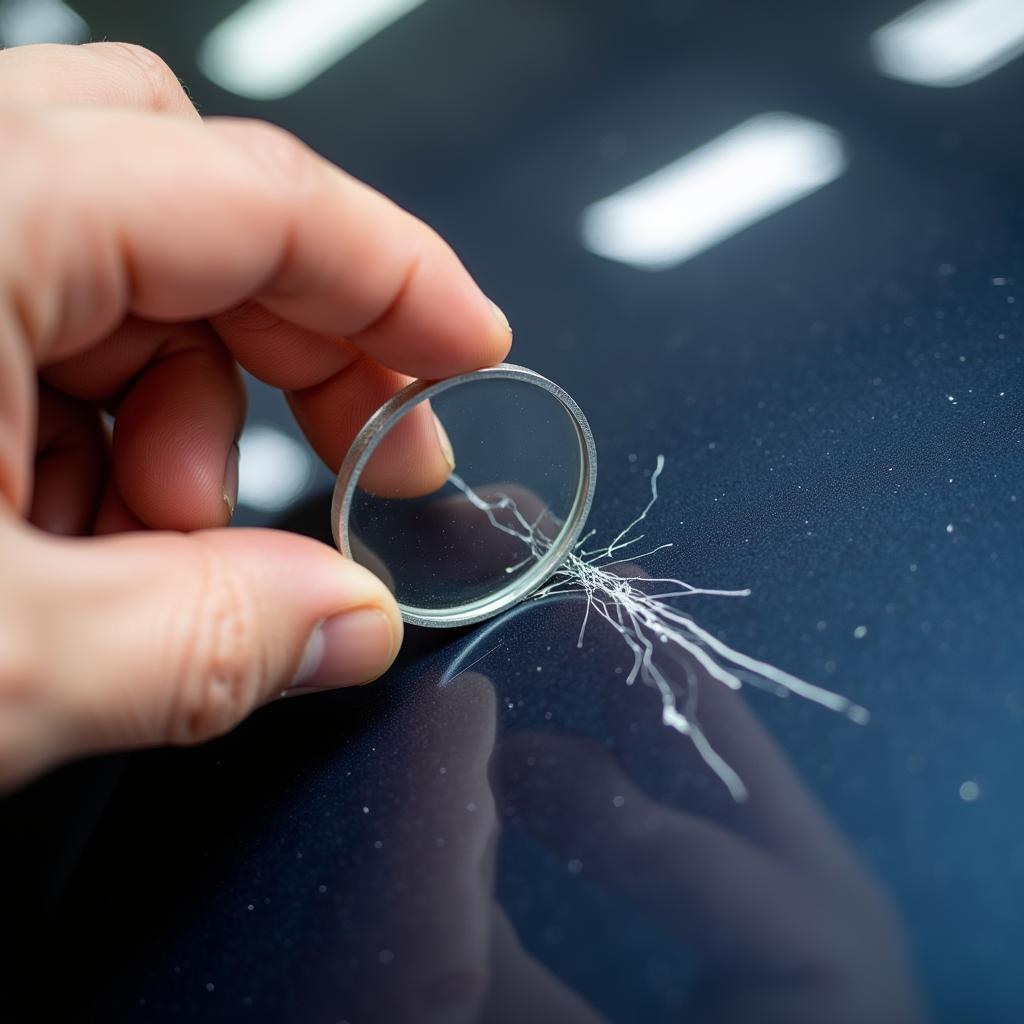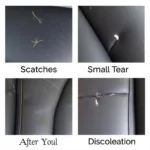The car paint repair process can seem daunting, but understanding the steps involved can empower you to make informed decisions and potentially even tackle minor repairs yourself. From minor scratches to more significant damage, this guide will walk you through the entire process, offering valuable insights and expert advice.
Repairing car paint involves several key stages, each crucial for achieving a professional and long-lasting finish. Whether you’re dealing with a small chip or a larger area of damage, understanding the process is essential. Let’s dive into the details of each step involved in the car paint repair process.
Assessing the Damage: The First Step in Car Paint Repair
Before beginning any car paint repair process, it’s crucial to thoroughly assess the damage. This involves identifying the type of damage, its extent, and the best course of action. Is it a minor scratch, a deep gouge, or perhaps a faded area? Knowing the specifics will help determine the necessary tools, materials, and techniques. Remember, accurate assessment is the foundation of a successful repair.
If you’re unsure about the extent of the damage, consider consulting with a professional for a more thorough evaluation. They can identify underlying issues that you might miss. Determining the severity of the damage will influence the cost and complexity of the repair.
 Assessing Car Paint Damage for Repair
Assessing Car Paint Damage for Repair
Preparing the Surface: Key to a Flawless Finish
Once you’ve assessed the damage, the next step in the car paint repair process is surface preparation. This involves cleaning the area thoroughly to remove dirt, grease, and any loose paint. Use a dedicated car wash soap and water, followed by a degreaser to ensure a pristine surface. This crucial step ensures proper adhesion of the new paint and prevents imperfections in the final finish. Even seemingly minor contaminants can compromise the repair.
After cleaning, you may need to sand the damaged area, starting with a coarser grit and gradually moving to a finer grit. This creates a smooth surface for the primer and paint to adhere to, resulting in a seamless repair. You might consider using a repair cracked paint on car approach for deeper cracks.
Priming and Painting: The Heart of the Car Paint Repair Process
Priming is essential for creating a strong bond between the existing paint and the new paint layer. Apply thin, even coats of primer, allowing each coat to dry completely before applying the next. After the primer has dried and cured, you can begin the painting process. Use a high-quality automotive paint that matches your car’s original color. Apply thin coats to prevent runs and ensure even coverage. This is often the step where you would use a best car paint chip repair kit vw for small, localized damage.
Consider factors like temperature and humidity when painting. These can affect the drying time and the overall finish. For specific paint issues like bird dropping damage, consider a bird droppings car paint repair wetsand technique.
Finishing Touches: Ensuring a Professional Result
After the paint has dried and cured, the final step in the car paint repair process is the finishing touches. This includes wet sanding and polishing to achieve a smooth, glossy finish. Use a fine-grit sandpaper and plenty of water to level any imperfections. Follow up with a polishing compound and a buffer to restore the shine.
Brisbane car paint repair professionals recommend using a sealant or wax to protect the newly repaired area and maintain its shine. These final steps are what separate a DIY repair from a professional-looking job. For filling in cracks and dents before painting, you can utilize a paint crack car repair bondo product.
Conclusion: Mastering the Car Paint Repair Process
The car paint repair process involves several crucial steps, from assessing the damage to applying the finishing touches. By understanding each stage, you can achieve a professional-looking repair and restore your car’s appearance. While minor repairs can be tackled with the right knowledge and tools, more significant damage may require the expertise of a professional. Remember, a well-maintained car reflects pride of ownership and contributes to its overall value. So, take the time to master the car paint repair process and keep your vehicle looking its best.
FAQ
- How long does the car paint repair process typically take? The timeframe depends on the extent of the damage, but it can range from a few hours for minor scratches to several days for more significant repairs.
- Can I repair car paint damage myself? Minor scratches and chips can often be repaired DIY, but more complex damage requires professional expertise.
- What type of paint should I use for car paint repair? Use high-quality automotive paint that matches your car’s original color.
- How can I prevent future car paint damage? Regular washing, waxing, and parking in shaded areas can help protect your car’s paint.
- What is the cost of professional car paint repair? The cost varies depending on the damage and the shop’s rates.
- Is it necessary to prime the surface before painting? Priming is crucial for adhesion and a long-lasting repair.
- How long should I wait before washing my car after a paint repair? Consult with the repair shop or paint manufacturer for specific drying and curing times.
Common Car Paint Repair Scenarios
- Scratches: From minor clear coat scratches to deep gouges, understanding the depth and type of scratch dictates the repair approach.
- Chips: Rock chips and other small impacts can be repaired with touch-up paint and clear coat.
- Dents: Dents often require bodywork and repainting of the affected area.
- Fading: Sun exposure can cause paint to fade. Restoring the original color may involve repainting the entire panel or even the whole car.
Related Articles and Questions
- How to remove scratches from car paint without damaging the clear coat?
- What is the best DIY car paint repair kit for beginners?
- How to match car paint color accurately?
Need further assistance? Contact us via WhatsApp: +1(641)206-8880 or Email: [email protected]. Our 24/7 customer service team is ready to help.


